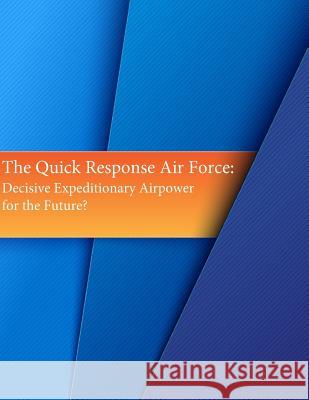The Quick Response Air Force: Decisive Expeditionary Airpower for the Future? » książka
The Quick Response Air Force: Decisive Expeditionary Airpower for the Future?
ISBN-13: 9781511592826 / Angielski / Miękka / 2015 / 50 str.
The Quick Response Air Force: Decisive Expeditionary Airpower for the Future?
ISBN-13: 9781511592826 / Angielski / Miękka / 2015 / 50 str.
(netto: 57,14 VAT: 5%)
Najniższa cena z 30 dni: 60,00
ok. 16-18 dni roboczych
Bez gwarancji dostawy przed świętami
Darmowa dostawa!
In his National Security Strategy, President William J. Clinton emphasized that the United States will remain globally engaged for many years to come, and that an integral part of that engagement will be the projection of military power. In the midst of budget cuts, personnel reductions, and base closures, the United States Department of Defense (DOD) is in a dilemma. It is being called on to be the dominant instrument of power in many regions of the world while its people and equipment are being stretched to their limits. Senior leaders are expressing serious concern for the operations tempo and are looking for relief. Unfortunately, the post-cold-war, multi-polar world is producing complex and unpredictable challenges with no end in sight. The DOD is being tasked to deter aggression, provide regional stability, support emerging democracies, and provide disaster relief. In many cases these tasks depend heavily on a forward presence. Prior to base closures and draw downs, much of this presence was in the form of permanent overseas bases and large numbers of forces transported to any place in the world. This is no longer the case and the question now is how to efficiently and effectively meet these challenges. Airpower offers the balanced solution. Its responsiveness, global reach, and flexibility generally give it an advantage over other military instruments in unexpected crises. Airpower is becoming the dominant quick-response weapon of choice in joint operations for the National Command Authorities (NCA). This study asks: How should the US military structure its forces to provide the NCA an on-call, sustainable, and responsive airpower force worldwide? This analysis concludes the answer is to reorganize existing forces into a Quick Response Airpower Force (QRAF). The QRAF concept involves a force structure that can help reduce the operations tempo in the DOD by replacing forward presence with a credible continental United States-based, quick response, deterrent force. This group of forces can be tailored to the unpredictable challenges of the future. In addition, it can allow the NCA the use of a force while avoiding putting a significant (and possibly unpopular) number of Americans in harm's way. The QRAF concept is divided into three levels: Level 1-a standing QRAF of collocated units, organized, trained and equipped for tasking at anytime, anywhere; Level 2-a preplanned QRAF of geographically separated units organized and designed well in advance for a specific deployment; and Level 3-an ad hoc QRAF employed if Levels 1 and 2 are already occupied or committed. This study presents a discussion and background of the problem, its importance, related problems, and past attempts at solutions. It offers a framework describing a quick response force and what it should be capable of doing. After discussing the current US Air Force attempts to provide this capability, the composite wing and the Airpower Expeditionary Force, the force of tomorrow-the three-tiered QRAF-is presented. The study concludes with recommendations for further study, limitations of the analysis, and its implications. Airpower is becoming the flexible, no-notice weapon of choice. Part of this airpower is the United States Air Force and part of the Air Force should be organized into the QRAF.
Zawartość książki może nie spełniać oczekiwań – reklamacje nie obejmują treści, która mogła nie być redakcyjnie ani merytorycznie opracowana.











